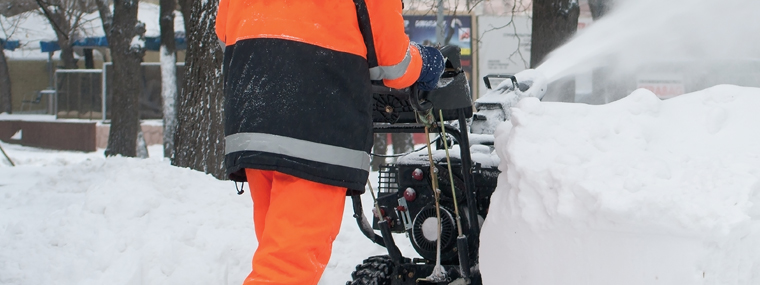
Winter Opportunities
By Diane M. Calabrese / Published December 2019

Maine and Montana may be out, but lots of other states are in.
Yes, it is possible to do at least some power washing across most of the United States in winter. But when the average January high is 28 °F (Augusta, ME) or 33 °F (Helena, MT), the opportunity will be too rare to consider.
What should a contractor include in a repertoire to be sure winter months are productive ones? Start with a dose of realism.
“Warmer weather is always going to be more profitable for power washing,” says Henry Bockman, president of Commercial Restorations in Germantown, MD. Yet each season brings different opportunities.
The perception that winter puts some limits on a contractor is correct, but it needs to be broadened to encompass the range of the possible. “Gutter cleaning is best when it’s raining often, but there is always something people will hire you for,” says Bockman.
The contractor must figure out what the “something” is, and it will vary by location. For instance, it may be easier to sell a homeowner on gutter cleaning when rain is being measured in inches than during a prolonged interval of dry weather when the gutters will be easier to clean.
The problem is, of course, most homeowners do not realize how clogged their gutters are until a rain is so heavy, they begin to overflow. Dry early winter days are a good time for a contractor to do—and sell—gutter cleaning.
Ice dam removal services, explains Bockman, is something his company adds in winter. All other services also continue.
“We provide the same services year-round except for wood restoration,” says Bockman. “In the D.C.-Metro area, work slows down, but we travel all over the country to perform government and commercial jobs.”
The Washington, D.C., metropolitan area where Bockman’s company is based is typical of many places across the middle of the contiguous lower 48 states. There can be winters that are almost snowless and those with snow accumulation so great it stops non-essential activity.
There are many homeowners who welcome contractors who will wash a house’s exterior on a January day when temperature and ground conditions permit. For the contractor, the goal is getting connected to them.
Before leaping to an app that ties a prospective customer directly to their business, contractors ought to consider whether they promote sufficient information about their winter services.
Let’s say an avid gardener whose plants are dormant in January wants to find a contractor who can carry in water to soft wash a house on a day when temperature permits. If the individual uses a search engine, will the contractor be found?
It’s relatively easy to convey “ice dam removal” to the liking of search engine optimizers, but it’s a bit difficult to get out word about warm-weather services carried year-round, weather cooperating. To economize, many contractors now rely on social media sites to get out the word about their services.
Yet the social media strategy may not be a good one for reaching prospective customers who will hit an unnecessary barrier before getting all text. Buyers of services who know what they want look for a streamlined path to a service provider. A website that includes the note, “we wash 12 months a year” and then details snow-day work-arounds (i.e., weather permitting, flexible scheduling) is often the much better choice.
It’s not just the cold but also the shorter days that slow down contractors in winter. Contractors who have their vehicles optimally arranged to access machines and ancillaries will be able to take full advantage of daylight hours.
From a distance, winter sometimes looks like W-I-N-T-E-R to a contractor in our industry. Let’s take that as a challenge and turn each letter of the word into a reminder of opportunity.
W-I-N-T-E-R
Widen—Look at the scope of a business in summer. Make it wider in winter. Gutter cleaning, ice dam removal, and snow removal are services that can be added in winter months. Contracting for jobs in a different geographic area is also a possibility—either as a primary or subcontractor.
Initiate—Get customers interested in having work done in winter when completing projects in summer. If a deck restoration customer is not interested in an exterior cleaning in July because the clematis are blooming, suggest they consider a winter wash.
Notices—Announcements, signs, posters, flyers—the quiet forms of advertising—should not be overlooked. The intensity of web-based ads that track an internet user and display seemingly everywhere at any time can become numbing. Most communities have advertising consolidators that send out mail packs periodically. Consider taking a slot in one of them. Advertise in less-than-expensive markets such as church bulletins. Ask a summer customer if a sign can be placed in the yard during cleaning to get the word out about winter work. Try something like “contact us about our great winter rates”—and use something similar on flyers.
Train—As Bockman reminds us, winter months will generally be slower than warmer months. Use the extra hours productively. Obtain a certification through an online course or travel to a course site.
Explore—Contractors who work as owner-operators may want to explore taking a pause as owner for a few months and working for another entity. Especially in states with heavy snowfall, such as Indiana and Illinois, contractors can find work plowing snow. For example, Illinois has a winter seasonal employment program (“Snowbird”) in which the Illinois Department of Transportation hires both full-time temporary highway maintainers and on-call, as-needed truck operators. (See http://www.idot.illinois.gov/about-idot/employment-opportunities/seasonal-employment/index).To quickly check on winter work availability in a particular state, use the USA.gov portal.
Re-equilibrate—Use winter months to prepare for the busy months that will follow. Maintain and update vehicles, equipment, and ancillaries. Reaffirm accounting procedures are the best possible to simplify tax reporting. Consider taking a vacation. By going the less-conventional route of a winter recreational break, a contractor retains more valuable days to complete jobs in warmer months.
Safety As Opportunity
Ladder work always adds some risk. Using a ladder when there is ice or snow on the ground is very risky. It’s the promise that a professional contractor can work safely in winter that homeowners want, particularly when they seek a contractor to remove ice dams.
A contractor interested in adding ice dam removal as a service should invest in the best possible steam equipment. The investment can be recouped quickly because the removal service easily commands $500 per hour and much more in complex situations.
Some ice dams are small and simple and can be tackled with a mallet and calcium chloride melt (never rock salt or sodium). But any team member or contractor dealing with ice dams must be properly trained to work off the ground and to properly use steam equipment.
Ice dams cause a great deal of anxiety to homeowners. The anxiety is justified. Eaves laden with a ridge of ice cause structural damage, and the damage can go far beyond pulling a gutter from a house.
As snow melts above the ice dam, it gets held up. (Because of heat of fusion, it takes more warmth to melt the ice than the snow, and the ice dam will hold strong, even as snow is melting.) That reservoir of water can get weighty and begin to leak into the home. Walls, ceiling, insulation, and more can be damaged.
A contractor may not want to go through a training program to become a certified energy inspector (and the professionals take different names in different states). However, it is something to consider because with an ice removal job completed, a contractor has the opportunity to promote safety (and energy conservation) by explaining to the customer that prevention of ice dams is the best approach.
Consider adding a service such as simple inspection and recommendations about preventing heat from escaping to a roof because of leaks or inadequate insulation. Do not overpromise. Develop a checklist, and then walk through the home with the owner to check what deserves more attention. Use a flat rate or an hourly rate.
When doing ice dam removal, be sure to take photos of gutter separations to remind homeowners how they benefit from having gutters cleaned. (Some ice dams begin with a pack of frozen debris inside a gutter.) Remind the homeowner that when leaves move into a downspout, they can obstruct the flow of water and cause an even more dramatic backup.
For more about the how and why of ice dams, see an excellent primer from the University of Minnesota Extension education services at extension.umn.edu/protecting-home-rain-and-ice/dealing-and-preventing-ice-dams.
Promoting safety—helping homeowners not only remove ice dams, but prevent them—is a valuable winter service. Contractors who decide to forego ice dams but do something as simple as attach a plow blade to a pickup and add snow removal to services are also making communities safer.
Think of winter as a season of unique opportunities. Identify and take advantage of them. It’s good business.





